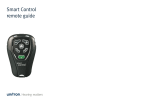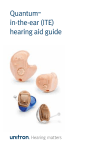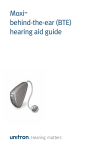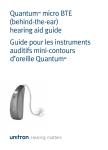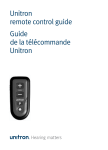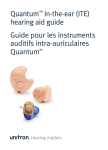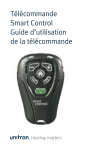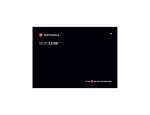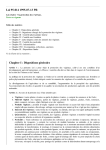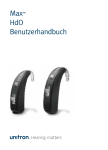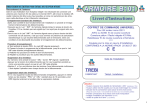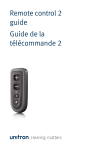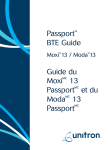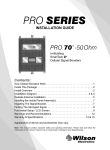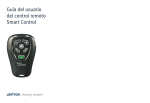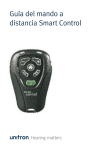Download PDF, 733 KB
Transcript
Smart Control remote guide Guide de la télécommande Smart Control Thank you Thank you for choosing Unitron Smart Control remote for your Unitron hearing aids. At Unitron, we care deeply about people with hearing loss. We work closely with hearing healthcare professionals to make advanced, purpose-driven solutions available to everyone. Because hearing matters. Remerciements Merci d’avoir choisi la télécommande Smart Control d’Unitron pour vos instruments auditifs Unitron. Chez Unitron, nous nous dévouons entièrement aux personnes souffrant de perte auditive. Nous travaillons en étroite collaboration avec des audioprothésistes afin de proposer des solutions de pointe, adaptées aux besoins de tous. Parce qu’entendre est important. Your Smart Control remote Hearing healthcare professional: _______________ __________________________________________ Telephone: _________________________________ Model: ____________________________________ Serial number:______________________________ Replacement batteries: One AAA (1.5 Volt), Standard or Rechargeable Warranty: __________________________________ Date of purchase: ___________________________ Quick reference Changing batteries 3 R 2 4 2 L R 6 1 7 8 L 5 9 10 11 Battery size AAA Low battery Warning left and right indicator lights blink alternately for 2 minutes On/off R L Off On 1 2 3 4 5 6 7 8 On-off switch Left-both-right switch Left (blue) indicator light Right (red) indicator light Scroll wheel +/– buttons Home button Telephone (or program) button 9 Program change button 10 LearnNow™ button 11 Battery compartment 1 Votre télécommande Smart Control Audioprothésiste :___________________________ __________________________________________ Téléphone : ________________________________ Modèle : ___________________________________ Numéro de série : ___________________________ Piles de remplacement : Une pile AAA (1,5 V), classique ou rechargeable Garantie : __________________________________ Date de l’achat : ____________________________ Aide-mémoire Remplacement des piles 3 R 2 4 2 L R 6 1 7 8 L 5 9 10 11 Type de pile AAA Avertissement de pile faible les voyants gauche et droit clignotent alternativement pendant 2 minutes Marche/arrêt R L Arrêt Marche 1 Bouton marche/arrêt 2 Bouton gauche/ bilatéral/droit 3 Voyant gauche (bleu) 4 Voyant droit (rouge) 5 Molette 6 Boutons +/– 7 Bouton d’accueil 8 Bouton téléphone (ou programme) 9 Bouton de changement de programme 10 Bouton LearnNowMC 11 Compartiment à pile 1 Table of contents / Table des matières Your Smart Control at a glance ...............................................2 Turning your Smart Control on and off....................................4 Replacing the battery ..............................................................5 Operating instructions.............................................................7 Adjusting your hearing aids with Smart Control.....................8 Accessories ............................................................................14 Caring for your Smart Control................................................15 Cleaning your Smart Control .................................................16 Troubleshooting guide...........................................................17 Warnings ................................................................................18 Aperçu de votre télécommande Smart Control.....................22 Mise en marche et arrêt de votre télécommande Smart Control ................................................................................24 Remplacement de la pile.......................................................26 Instructions d’utilisation .......................................................28 Réglage de vos instruments auditifs avec la télécommande Smart Control .....................................................................30 Accessoires............................................................................37 Entretien de votre télécommande Smart Control .................38 Nettoyage de votre télécommande Smart Control ...............39 Guide de dépannage.............................................................40 Avertissements......................................................................42 Declaration of conformity......................................................47 Your Smart Control at a glance 1 On-off switch - turn your remote control on or off and also lock it to avoid sending unintentional commands 2 Left-both-right switch - allows you to select the hearing aid you want to adjust 3 Left (blue) indicator light - flashes to indicate your left hearing aid is being adjusted 4 Right (red) indicator light - flashes to indicate your right hearing aid is being adjusted 5 Scroll wheel* - allows you to manage the levels of speech and background noise in your hearing aids 6 Volume control buttons* - adjusts the volume of your hearing aids 7 Home button - returns your hearing aids to their startup program 8 Telephone (or program) button - switches the hearing aid to the telephone program 9 Program change button - advances your hearing aid to their next listening program 10 LearnNow™ button - teaches your hearing aids your preferred settings in different listening programs 11 Battery compartment - allows access to change the battery * Control may be customized by your hearing healthcare professional so that the functions of 5 and 6 may be swapped. 2 3 2 4 6 1 7 8 5 9 10 2 R 5 L 1 11 3 Turning your Smart Control on and off Your Smart Control has an On-Off (or travel lock) switch on the left side of the remote. To turn the remote control on, slide the switch into the On or unlocked position . To turn the remote control off, slide the switch into the Off or locked position . Sliding the switch to the Off position will avoid sending unintentional commands to your hearing aids (while the remote is in your handbag or pocket, for example). R L Off On 4 Replacing the battery The battery compartment is located on the back of the Smart Control. 1. Slide the battery cover in the direction of the arrow. 2. Grasp the old battery with your thumb and index finger and remove. 3. Insert the new battery into the battery compartment in the correct +/- position, placing the battery’s minus (-) end into the compartment first. 4. Slide the battery cover in the opposite direction of the arrow. R L R L 5 Low battery warning When you see the left and right indicator lights blink alternating blue and red for two seconds, your Smart Control is warning you that the battery in your remote is low. You will see the warning every time you turn on your Smart Control or send a command to your hearing aids until you change the battery or the battery dies. Caring for batteries Always discard batteries in a safe and environmentally friendly way To prolong battery life, remember to turn the remote control off when not in use 6 Operating instructions Before using your Smart Control, turn on your hearing aids to ensure they are able to receive the Smart Control commands. Smart Control is designed to be used comfortably in your hand at a maximum distance of one arm’s length. You do not have to point the remote at your hearing aids. Placing the remote control directly next to or too close to your hearing aids may decrease the remote’s effectiveness. Selecting which hearing aid to adjust At the top of the remote control, there is a Left-Both-Right switch. This switch allows you to select the hearing aids you want to adjust. L to R Slide the switch to the left position adjust your left hearing aid only. The left (blue) indicator light will flash to indicate your left hearing aid is being adjusted. 7 Slide the switch to the right position R to L adjust your right hearing aid only. The right (red) indicator light will flash to indicate your right hearing aid is being adjusted. L Slide the switch to the center positionR to adjust both your hearing aids. Both indicator lights will flash to indicate your left and right hearing aids are being adjusted at once. Adjusting your hearing aids with Smart Control Your Smart Control provides backlighting when it is first turned on and each time a button is pressed, allowing you to see the remote buttons in dimly lit environments. Scroll wheel comfort-clarity setting (Available with Quantum™ 20 and 12, Moxi™ 20 and 12, Passport™, Latitude™ 16, Yuu™ L and Next™ 16Rhearing aids) The scroll wheel allows you to manage the levels of speech and 8 background noise in your hearing aids and provides an additional fine tuning adjustment beyond a traditional volume control. Scroll the wheel up slowly to increase the clarity of sounds, such as speech. Scroll the wheel down slowly to increase comfort in noisy listening situations. As the wheel is adjusted, your hearing aids may beep. Please refer to your hearing aid guide for more information on your control feature. Volume control buttons To increase the volume on your hearing aids, press the + button on your Smart Control. To decrease the volume on your hearing aids, press the – button on your Smart Control. As the volume is adjusted, your hearing aids 9 may beep. Please refer to your hearing aid guide for more information on your hearing aids’ volume beeps. Note: Your hearing healthcare professional may configure the scroll wheel as your volume control and your +/– buttons as your comfortclarity control. Telephone (or program) button To switch to the telephone program, press the Telephone button. The telephone button can also be set to provide you with direct access to another specified listening program that your hearing healthcare professional has selected for you. Talk to your hearing healthcare professional to find out how your telephone button has been configured. To exit the telephone program, press the Home button. 10 Telephone button with Binaural Phone (Binaural Phone exclusive to wireless styles of Quantum 20 and 12, Moxi 20 and 12 as well as Passport and Latitude 16 hearing aids) To switch to the Binaural Phone program, press the Telephone button once. This will allow you to hear the conversation through both hearing aids automatically. Press the Telephone button again, and this will allow you to hear the phone conversation in only one ear. To exit the Binaural Phone program, press the Home button. Program Change button To change the current listening program of your hearing aids, press the Program Change button. The hearing aid will advance to the next listening program. Please refer to your hearing aid guide to determine which programs are available to you and their program beep notifications. 11 LearnNow™ button (Available with Quantum 20, Moxi 20, Passport and Yuu hearing aids) The LearnNow™ button teaches your hearing aids the volume and comfortclarity settings you prefer in different listening environments. When you press the LearnNow button, Smart Control sends a command to your hearing aids to learn your current settings more quickly. By teaching your hearing aids you are personalizing your volume and comfort-clarity settings and minimizing the need for adjustments when you are in a similar listening environment in the future. Note: The LearnNow button should be pressed after you have adjusted the volume and/or comfort-clarity settings to your preferred levels. After pressing the LearnNow button, your hearing aids will beep if the command was successfully received. 12 Note: The LearnNow button on your Smart Control may be deactivated by your hearing healthcare professional and, therefore, could be inactive. Note: On Passport and Yuu the LearnNow button will only work when your hearing aids are set to the automatic program. Home button The Home button returns both of your hearing aids to their start-up program, similar to when you first turn on your hearing aids. This button can be useful when you want your hearing aids, regardless of the position of the Left-Both-Right switch, to return to the start-up program and the volume and comfort-clarity settings when your hearing aids are first turned on. Please refer to your hearing aid guide to determine which program is your start-up program. 13 Accessories Your Smart Control can be used with a lanyard so that you can carry the remote around your neck or wrist. Attach the lanyard to the remote, as illustrated below. 1. 2. 5. 14 6. 3. 4. 7. Caring for your Smart Control Open the battery compartment and remove the battery if the remote control will not be used for long periods of time. Do not use your Smart Control in the bath or shower or immerse it in water. If your remote control does become wet, do not attempt to dry it in an oven or microwave. Do not adjust any controls. Open the battery compartment and remove the battery to allow your remote control to dry naturally for 24 hours. Protect your remote control from excessive heat (hair dryer, vehicle glove box or dashboard). Do not drop your remote control or knock it against hard surfaces. 15 Cleaning your Smart Control Do not use alcohol to clean your remote control. Use a damp cloth to clean the outside of the remote. 16 Troubleshooting guide Refer to the troubleshooting table below if you are having problems with your Smart Control. For problems with your hearing aids, please consult your hearing aid guide. Cause Possible remedy Indicator lights not flashing Turn on Not turned on Low/dead battery Replace battery Poor battery contact Consult your hearing healthcare professional Battery upside down Insert battery plus (+) side up Indicator lights flashing rapidly Replace battery Low battery Hearing aids not responding to Smart Control commands Move the remote control Holding the remote control too far away closer to you Holding the remote control too close Move the remote to a maximum distance of one arm’s length For any problems not listed in the guide, contact your hearing healthcare professional. If you do not have a hearing healthcare professional, please contact the nearest office listed on the back page of this booklet. 17 Warnings Smart Control should only be used as directed by your hearing healthcare professional. Smart Control uses a low-power, digitally coded inductive transmission to communicate to your hearing aids. Although unlikely, interference with medical devices such as pacemakers is possible. Interference should not occur with normal use, holding the remote comfortably in the hand, 4 inches (10 centimeters) or more from the body. Therefore, it is recommended that pacemaker users do not keep the remote control in a breast pocket. Do not use Smart Control in explosion hazard areas. Do not use Smart Control in locations forbidden to use electronic devices, such as an airplane. 18 Store your Smart Control in a safe location for CT and MRI scans or for other electromagnetic procedures. Changes or modifications made to the Smart Control not expressly approved by Unitron Hearing may void the user’s authority to operate the equipment. Battery warnings Never leave your remote control or batteries where small children and pets can reach them. Never put your remote control or batteries in your mouth. If a battery is swallowed, call a physician immediately. Precautions If your Smart Control fails to operate after you have correctly inserted a new battery, contact your hearing healthcare professional. Always bring both your Smart Control, and your hearing aids for service questions. 19 Your Smart Control and your hearing aids are given a unique communication code. Because of this code, your Smart Control will not affect hearing aids worn by others. Your Smart Control uses the most modern components to provide an extremely reliable experience with virtually no interference from other devices. However, when operating the Smart Control near a computer terminal, communication device such as a digital cell phone, or other strong electromagnetic field, it may be necessary to be at least 24 inches (60 centimeters) away to ensure proper operation. If your hearing aids do not respond to the Smart Control because of an unusual field disturbance, move away from the disturbing field. 20 Labeling The serial number and year of manufacture are located inside the battery compartment. Please fill out the contact information sticker provided with your new Smart Control which is located inside the battery compartment. 21 Aperçu de votre télécommande Smart Control 1 Interrupteur marche/arrêt : vous permet de mettre en marche et d’arrêter votre télécommande, ainsi que de la verrouiller pour éviter d’envoyer accidentellement des commandes 2 Interrupteur gauche/bilatéral/droit : vous permet de sélectionner l’instrument auditif que vous voulez régler 3 Voyant gauche (bleu) : clignote pour indiquer que vous êtes en train de régler votre instrument auditif gauche 4 Voyant droit (rouge) : clignote pour indiquer que vous êtes en train de régler votre instrument auditif droit 5 Molette* : vous permet de régler le volume des paroles et des bruits de fond sortant de vos instruments auditifs 6 Boutons de commande de volume* : permet de régler le volume de vos instruments auditifs 7 Bouton d’accueil : permet de rétablir le programme de démarrage de vos instruments auditifs 8 Bouton téléphone (ou programme) : permet de faire passer les instruments auditifs au programme téléphonique * Votre audioprothésiste peut personnaliser le réglage afin que les commandes 5 et 6 puissent être permutées. 22 9 Bouton de changement de programme : permet de faire passer vos instruments auditifs au prochain programme d’écoute 10 Bouton LearnNowMC : permet à vos instruments auditifs d’enregistrer vos réglages préférés pour différents programmes d’écoute 11 Compartiment à pile : vous permet d’avoir accès à la pile pour la remplacer 3 2 4 2 R 6 1 7 8 5 L 1 9 10 11 23 Mise en marche et arrêt de votre télécommande Smart Control Votre télécommande Smart Control est dôtée d’un interrupteur marche/arrêt (ou de verrouillage de voyage) sur le côté gauche. Pour mettre la télécommande en marche, faites glisser l’interrupteur vers la position Marche ou la position de déverrouillage . Pour arrêter la télécommande, faites glisser l’interrupteur vers la position Arrêt ou la position de verrouillage . Mettre l’interrupteur sur la position Arrêt permettra d’éviter d’envoyer accidentellement des commandes à vos instruments auditifs (lorsque la télécommande se trouve dans votre sac à main ou votre poche, par exemple). 24 R L Arrêt Marche 25 Remplacement de la pile Le compartiment à pile est situé à l’arrière de la télécommande Smart Control. 1. Faites glisser le couvercle du compartiment à pile dans le sens de la flèche. 2. Attrapez la pile usagée à l’aide de votre pouce et de votre index puis retirez-la. 3. Placez la pile neuve dans le compartiment à pile en respectant la polarité +/- et en commençant par insérer l’extrémité négative (-) de la pile dans le compartiment. 4. Faites glisser le couvercle du compartiment dans le sens opposé de la flèche. R 26 L R L Avertissement de pile faible Lorsque vous voyez les voyants gauche et droit clignoter alternativement du bleu au rouge pendant deux secondes, votre télécommande Smart Control vous avertit que sa pile est presque épuisée. Vous verrez cet avertissement chaque fois que vous mettrez votre télécommande Smart Control en marche ou lorsqu’un signal est envoyé à vos instruments auditifs et ce, jusqu’à ce que la pile soit remplacée ou complètement épuisée. Entretien des piles Débarrassez-vous toujours des piles de manière sûre et écologique. Pour prolonger la durée de vie de la pile, pensez à arrêter la télécommande lorsque vous ne l’utilisez pas. 27 Instructions d’utilisation Avant d’utiliser votre télécommande Smart Control, mettez vos instruments auditifs en marche pour vous assurer qu’ils reçoivent les commandes de la télécommande Smart Control. La télécommande Smart Control a été conçue pour tenir de façon confortable dans votre main et être utilisée à une distance maximale équivalente à la longueur d’un bras. Il n’est pas nécessaire de pointer la télécommande vers vos instruments auditifs. Placer la télécommande directement à côté ou trop près de vos instruments auditifs peut diminuer son efficacité. Sélection de l’instrument auditif à régler Sur le dessus de la télécommande se trouve un interrupteur gauche/bilatéral/droit. Cet interrupteur vous permet de sélectionner les instruments auditifs que vous voulez régler. 28 Faites glisser l’interrupteur vers la position L pour régler uniquement votre R gauche instrument auditif gauche. Le voyant gauche (bleu) clignotera pour indiquer que vous êtes en train de régler votre instrument auditif gauche. Faites glisser l’interrupteur vers la position L droit R pour régler uniquement votre instrument auditif droit. Le voyant droit (rouge) clignotera pour indiquer que vous êtes en train de régler votre instrument auditif droit. Faites glisser l’interrupteur vers la position L centraleR pour régler vos deux instruments auditifs. Les deux voyants clignoteront pour indiquer que vous êtes en train de régler vos deux instruments auditifs simultanément. 29 Réglage de vos instruments auditifs avec la télécommande Smart Control Votre télécommande Smart Control est rétroéclairée lorsqu’elle est mise en marche pour la première fois, puis chaque fois qu’un bouton est utilisé. Cela vous permet de voir les boutons de la télécommande dans les environnements peu éclairés. Réglage de la molette confort/clarté (disponible sur les instruments auditifs QuantumMC 20 et 12, MoxiMC 20 et 12, PassportMC, LatitudeMC 16,R YuuMCL et NextMC 16) La molette vous permet de régler le volume des paroles et des bruits de fond sortant de vos instruments auditifs. Elle fournit également une option de réglage de précision supplémentaire qui surpasse la commande de volume traditionnelle. Tournez la molette lentement vers le haut 30 pour augmenter la clarté sonore, notamment des paroles. Tournez la molette lentement vers le bas pour augmenter le niveau de confort dans les environnements bruyants. Lors du réglage de la molette, vos instruments auditifs peuvent émettre un bip. Veuillez consulter le manuel de vos instruments auditifs pour obtenir de plus amples renseignements sur votre fonction de réglage. Boutons de commande de volume Pour augmenter le volume de vos instruments auditifs, appuyez sur le bouton + de votre télécommande Smart Control. Pour diminuer le volume de vos instruments auditifs, appuyez sur le bouton – de votre télécommande Smart Control. 31 Lors du réglage du volume, vos instruments auditifs peuvent émettre un bip. Veuillez consulter le manuel de vos instruments auditifs pour obtenir plus de renseignements sur les bips de volume. Remarque : votre audioprothésiste peut configurer la molette comme une commande de volume et vos boutons +/– comme une commande de réglage du confort/clarté. Bouton téléphone (ou programme) Pour passer au programme téléphonique, appuyez sur le bouton téléphone. Le bouton téléphone peut également être configuré pour vous offrir un accès direct à un autre programme d’écoute particulier que votre audioprothésiste a sélectionné pour vous. Consultez votre audioprothésiste pour savoir comment le bouton téléphone de votre télécommande a été configuré. 32 Pour quitter le programme téléphonique, accueil. appuyez sur le bouton d’a Bouton téléphone avec programme téléphonique binaural (le programme téléphonique binaural est exclusif aux modèles d’instruments auditifs sans fil Quantum 20 et 12, Moxi 20 et 12, ainsi qu’aux les instruments auditifs Passport et Latitude 16) Pour passer au programme téléphonique binaural, appuyez une fois sur le bouton téléphone. Cela vous permettra d’entendre automatiquement la conversation dans vos deux instruments auditifs. Appuyez à nouveau sur le bouton téléphone pour entendre la conversation téléphonique dans une seule oreille. Pour quitter le programme téléphonique binaural, appuyez sur le bouton accueil. d’a 33 Bouton de changement de programme Pour changer le programme d’écoute actuellement sélectionné pour vos instruments auditifs, appuyez sur le bouton de changement de programme. Les instruments auditifs passeront alors au programme d’écoute suivant. Veuillez consulter le manuel de vos instruments auditifs pour déterminer les programmes disponibles pour vous et leurs notifications par bip. Bouton LearnNowMC (disponible sur les instruments auditifs Quantum 20, Moxi 20, Passport et Yuu) Le bouton LearnNowMC indique à vos instruments auditifs les réglages de volume et de confort/clarté que vous préférez selon les différents environnements sonores. Lorsque vous appuyez sur le bouton LearnNow, la télécommande Smart Control envoie une commande à vos instruments auditifs leur intimant d’enregistrer plus 34 rapidement vos réglages actuels. Cet enregistrement par vos instruments auditifs vous permet de personnaliser vos réglages de volume et de confort/clarté, et de minimiser la nécessité de procéder à des réglages lorsque vous vous trouverez dans un environnement sonore semblable à l’avenir. Remarque : n’appuyer sur le bouton LearnNow qu’après avoir ajusté les réglages de volume et/ou de confort/clarté selon vos niveaux préférés. Une fois que vous avez appuyé sur le bouton LearnNow, vos instruments auditifs émettront un bip si la commande a bien été reçue. Remarque : le bouton LearnNow de votre télécommande Smart Control peut avoir été désactivé par votre audioprothésiste et, en conséquence, être inactif. Remarque : sur les modèles Passport et Yuu, le bouton LearnNow ne fonctionne que lorsque vos instruments auditifs sont réglés sur le programme automatique. 35 Bouton d’accueil accueil fait passer vos Le bouton d’a deux instruments auditifs à leur programme de démarrage, comme lors de leur mise en marche initiale. Ce bouton peut être utile lorsque vous souhaitez rétablir le programme de démarrage et les réglages de volume et de confort/clarté de la première mise en marche de vos instruments auditifs, quelle que soit la position de l’interrupteur “gauche/bilatéral/droit”. Veuillez consulter le manuel de vos instruments auditifs pour déterminer votre programme de démarrage. 36 Accessoires Votre télécommande Smart Control peut être utilisée avec un cordon de manière à pouvoir la porter autour de votre cou ou de votre poignet. Attachez le cordon à la télécommande, comme le montre l’illustration ci-dessous. 1. 2. 5. 6. 3. 4. 7. 37 Entretien de votre télécommande Smart Control Ouvrez le compartiment à pile et retirez la pile si vous ne pensez pas utiliser la télécommande pendant une longue période. N’utilisez pas votre télécommande Smart Control dans le bain ou sous la douche et ne l’immergez pas dans l’eau. Si votre télécommande venait à être mouillée, n’essayez pas de la faire sécher dans un four traditionnel ou à micro-ondes. N’ajustez pas les commandes. Ouvrez le compartiment à pile et retirez la pile pour laisser votre télécommande sécher à l’air libre pendant 24 heures. Protégez votre télécommande contre la chaleur excessive (sèche-cheveux, boîte à gants ou tableau de bord). Ne laissez pas votre télécommande tomber ou heurter des surfaces dures. 38 Nettoyage de votre télécommande Smart Control N’utilisez pas d’alcool pour nettoyer votre télécommande. Utilisez un chiffon humide pour nettoyer l’extérieur de la télécommande. 39 Guide de dépannage Consultez le tableau de dépannage ci-dessous si vous rencontrez des problèmes avec votre télécommande Smart Control. Veuillez consulter le manuel de vos instruments auditifs pour les problèmes relatifs à vos instruments auditifs. Symptôme Solution possible Les voyants ne clignotent pas Mettre en marche Pas en marche Pile faible ou épuisée Remplacer la pile. Consultez votre audioprothésiste Mauvais contact Pile à l’envers Insérer la pile avec le signe plus (+) vers le haut Les voyants clignotent rapidement Remplacer la pile Pile faible Les instruments auditifs ne répondent pas aux commandes de la télécommande Smart Control Rapprocher la La télécommande télécommande vers vous se situe trop loin La télécommande se situe trop près 40 Éloigner la télécommande à une distance maximale équivalente à la longueur d’un bras Pour tout problème ne figurant pas dans ce guide, communiquez avec votre audioprothésiste. Si vous êtes à la recherche d’un audioprothésiste, veuillez communiquer avec l’agence la plus proche, dont les coordonnées figurent au dos de ce livret. 41 Avertissements La télécommande Smart Control doit être utilisée conformément aux instructions de votre audioprothésiste. La télécommande Smart Control utilise une transmission inductive numérisée à faible puissance pour communiquer avec vos instruments auditifs. Bien qu’improbables, des interférences avec des appareils médicaux, comme des stimulateurs cardiaques, sont possibles. Des interférences ne devraient pas se produire dans le cadre d’une utilisation normale, c’est-à-dire en tenant bien la télécommande dans la main, à au moins 10 centimètres du corps. Par conséquent, il est recommandé aux porteurs d’un stimulateur cardiaque de ne pas mettre la télécommande dans une poche poitrine. 42 La télécommande Smart Control ne doit pas être utilisée dans des zones présentant un danger d’explosion. N’utilisez pas la télécommande Smart Control dans les endroits où l’utilisation d’appareils électroniques est interdite, comme les avions. Rangez votre télécommande Smart Control dans un endroit sûr lors de tomodensitogrammes, d’examens par IRM ou d’autres procédures électromagnétiques. Les changements ou modifications apportés à la télécommande Smart Control qui n’ont pas été expressément approuvés par Unitron Hearing peuvent annuler l’autorisation d’utilisation de l’équipement par l’utilisateur. 43 Avertissements concernant les piles Ne laissez jamais votre télécommande ou les piles à la portée de jeunes enfants ou d’animaux. Ne mettez jamais votre télécommande ou les piles dans votre bouche. Si une pile est ingérée, appelez immédiatement un médecin. Précautions Si votre télécommande Smart Control ne fonctionne pas une fois la pile neuve correctement installée, communiquez avec votre audioprothésiste. Apportez toujours votre télécommande Smart Control ainsi que vos instruments auditifs pour toute question de réparation. Votre télécommande Smart Control et vos instruments auditifs sont dotés d’un code de communication unique. Grâce à ce code, votre télécommande Smart Control n’a aucun effet sur les instruments auditifs d’autres utilisateurs. 44 Votre télécommande Smart Control utilise les composants les plus modernes pour vous offrir une expérience extrêmement fiable et une absence quasi-totale d’interférences avec d’autres appareils. Toutefois, lorsque vous utilisez la télécommande Smart Control près d’un ordinateur, d’un appareil de communication, comme un téléphone cellulaire numérique, ou d’un autre champ magnétique fort, vous devrez peut-être vous éloigner d’au moins 60 centimètres pour que la télécommande fonctionne bien. Si vos instruments auditifs ne répondent pas à la télécommande Smart Control à cause d’une perturbation inhabituelle due à un champ magnétique, éloignez-vous de celui-ci. 45 Identification Le numéro de série et l’année de fabrication sont indiqués à l’intérieur du compartiment à pile. Veuillez indiquer vos coordonnées sur l’autocollant fourni avec votre nouvelle télécommande Smart Control et situé à l’intérieur du compartiment à pile. 46 Declaration of conformity Hereby, Unitron Hearing declares that Smart Control is in compliance with the essential requirements and other relevant provisions of Directive 93/42/EEC. To obtain a copy of the Declaration of Conformity, please contact your local representative from the list of Unitron Hearing Distributors. This device complies with part 15 of the FCC rules and with RSS 210 of Industry Canada. Operation is subject to the following two conditions: (1) This device does not cause harmful interference, and (2) this device must accept any interference received, including interference that may cause undesired operation. 47 Guidance and manufacturer’s declaration - electromagnetic emissions The Model Smart Control is intended for use in the electromagnetic environment specified below. The customer or the user of the Model Smart Control should assure that it is used in such an environment. Emission test Compliance Electromagnetic environment guidance RF emissions CISPR 11 Group 2 The Model Smart Control must emit electromagnetic energy in order to perform its intended function. Nearby electronic equipment may be affected. RF emissions CISPR 11 Class B The Model Smart Control is suitable for use in all establishments, including domestic establishments and those directly connected to the public low-voltage power supply network that supplies buildings used for domestic purposes. Harmonic emissions IEC 61000-3-2 Not applicable Voltage fluctuations/ flicker emissions IEC 61000-3-3 Not applicable Table 201 48 Guidance and manufacturer’s declaration – electromagnetic immunity The Model Smart Control is intended for use in the electromagnetic environment specified below. The customer or the user of the Model Smart Control should assure that it is used in such an environment. Immunity test Electrostatic discharge (ESD) IEC 60601 test level Compliance level ±6 kV contact ±8 kV air ±6 kV contact ±8 kV air Floors should be wood, concrete or ceramic tile. If floors are covered with synthetic material, the relative humidity should be at least 30%. ±2 kV for power supply lines ±1 kV for input/output lines Not applicable Mains power quality should be that of a typical commercial or hospital environment. ±1 kV line(s) to line(s) ±2 kV line(s) to earth Not applicable Mains power quality should be that of a typical commercial or hospital environment. IEC 61000-4-2 Electrical fast transient/burst IEC 61000-4-4 Surge IEC 61000-4-5 Voltage dips, short interruptions and voltage variations on power supply input lines <5% UT (>95% dip in UT) Not applicable for 0,5 cycle 40% UT (60% dip in UT) for 5 cycles 70% UT (30% dip in UT) for 25 cycle IEC 61000-4-11 <5% UT (>95% dip in UT) for 5 sec Power frequency (50/60 Hz) magnetic field Electromagnetic environment - guidance 3 A/m 3 A/m IEC 61000-4-8 Mains power quality should be that of a typical commercial or hospital environment. If the user of the Model Smart Control requires continued operation during power mains interruptions, it is recommended that the Model Smart Control be powered from an uninterruptible power supply or a battery. Power frequency magnetic fields should be at levels characteristic of a typical location in a typical commercial or hospital environment. NOTE: UT is the a.c. mains voltage prior to application of the test level. Table 202 49 Guidance and manufacturer’s declaration – electromagnetic immunity The Model Smart Control is intended for use in the electromagnetic environment specified below. The customer or the user of the Model Smart Control should assure that it is used in such an environment. Immunity test IEC 60601 Compliance Electromagnetic environment - guidance test level level Portable and mobile RF communications equipment should be used no closer to any part of Smart Control, including cables, than the recommended separation distance calculated from the equation applicable to the frequency of the transmitter. Recommended separation distance Conducted RF IEC 61000-4-6 3 Vrms 150 kHz to 80 MHz Not applicable d = 1,2 Radiated RF IEC 61000-4-3 3 V/m 80 MHz to 2,5 GHz 3 V/m d = 1,2 80 MHz to 800 MHz d = 2,3 800 MHz to 2,5 GHz where P is the maximum output power rating of the transmitter in watts (W) according to the transmitter manufacturer and d is the recommended separation distance in meters (m). Field strengths from fixed RF transmitters, as determined by an electromagnetic site survey,a should be less than the compliance level in each frequency rangeb. Interference may occur in the vicinity of equipment marked with the following symbol: NOTE 1: At 80 MHz and 800 MHz, the higher frequency range applies. NOTE 2: These guidelines may not apply in all situations. Electromagnetic propagation is affected by absorption and reflection from structures, objects and people. a Field strengths from fixed transmitters, such as base stations for radio (cellular/cordless) telephones and land mobile radios, amateur radio, AM and FM radio broadcast and TV broadcast cannot be predicted theoretically with accuracy. To assess the electromagnetic environment due to fixed RF transmitters, an electromagnetic site survey should be considered. If the measured field strength in the location in which the Model Smart Control is used exceeds the applicable RF compliance level above, the Model Smart Control should be observed to verify normal operation. If abnormal performance is observed, additional measures may be necessary, such as re-orienting or relocating the Model Smart Control. b Over the frequency range 150 kHz to 80 MHz, field strengths should be less than 3 V/m. 50 Table 204 Recommended separation distances between portable and mobile RF communications equipment and the Model Smart Control The Model Smart Control is intended for use in an electromagnetic environment in which radiated RF Disturbances are controlled. The customer or the user of the Model Smart Control can help prevent electromagnetic interference by maintaining a minimum distance between portable and mobile RF communications equipment (transmitters) and the Model Smart Control as recommended below, according to the maximum output power of the communications equipment. Rated maximum output power of transmitter W Separation Distance according to frequency of transmitter m 150 kHz to 80 MHz d = 1,2 80 MHz to 800 MHz d = 1,2 800 MHz to 2,5 GHz d = 2,3 0.01 0.12 0.12 0.23 0.1 0.38 0.38 0.73 1 1.2 1.2 2.3 10 3.8 3.8 7.3 100 12 12 23 For transmitters rated at a maximum output power not listed above, the recommended separation distance d in meters (m) can be estimated using the equation applicable to the frequency of the transmitter, where P is the maximum output power rating of the transmitter in watts (W) according to the transmitter manufacturer. NOTE 1: At 80 MHz and 800 MHz, the higher frequency range applies. NOTE 2: These guidelines may not apply in all situations. Electromagnetic propagation is affected by absorption and reflection from structures, objects and people. Table 206 51 Unitron distributors/Distributeurs Unitron Corporate office/International 20 Beasley Drive, P.O. Box 9017, Kitchener, ON N2G 4X1 Canada France 5 bis, rue Maryse Bastié - BP 15 69671 Bron Cedex Spain/Espagne Avenida de la Industria nº13/15, Polígono de Canastell, 03690 India/Inde Sant Vicent del Belgium/Belgique B-308, Everest Grande, Raspeig. Alicante, Baron de Vironlaan, 60 Mahakali Caves Road, España Andheri East, b-1700 Dilbeek Sweden/Suède Mumbai-400 093 Canada Förmansvägen 2, 4 Netherlands/Pays-Bas tr SE-11743, 20 Beasley Drive, P.O. Box 9017, Kitchener, ON Ir. D.S. Tuijnmanweg Stockholm N2G 4X1 10, 4131 PN VIANEN United Kingdom/ China/Chine New Zealand/ Royaume-Uni Nouvelle-Zélande No. 78, Qi Ming Road, St. George House, Export Processing Zone 10/215 Rosedale Rd., Cygnet Court, District B, Suzhou M277 Private Bag, Centre Park, Industrial Park, P.R. 300987, Albany, Warrington, 215021 Auckland Cheshire WA1 1PD Denmark/Danemarque Russia/Russie U.S.A./Etats-Unis Nitivej 10, DK-2000 Tverskaya str. 16, Suite A, 2300 Frederiksberg bldg. 3, 1st floor Berkshire Lane Moscow, 125009 North, Plymouth, Germany & European MN 55441 Representative/ South Africa/ Représentant Européen Afrique du Sud Daimlerstrasse 22, First Floor – Selborne 70736 FellbachHouse, Fourways Golf Oeffingen, Allemagne Park, Roos Street, Fourways, Johannesburg Australia/Australie Level 2, Norwest Quay, 21 Solent Circuit, Baulkham Hills, NSW, NSW 2153 Unitron Hearing Ltd. 20 Beasley Drive, case postale 9017, Kitchener, ON N2G 4X1 Canada Distributor/Distributeur www.unitron.com/ca K/10-047 029-5645



























































